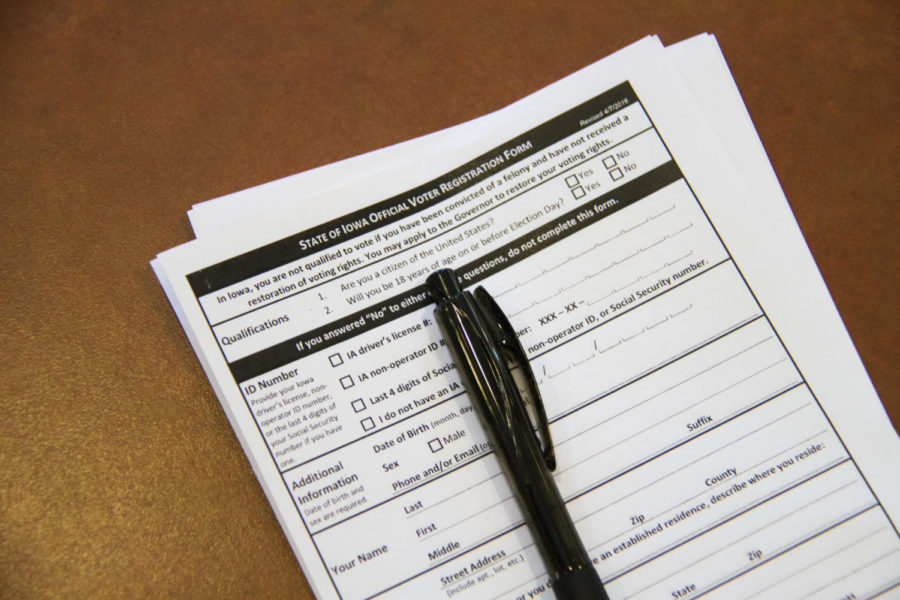AP Gov: Will early voting have an effect on the election
Students can visit the Story County website to receive information about registering to vote, sending in absentee ballots and the election in general.
October 25, 2020
The 2020 election has seen a surge in early voting, about 10 percent of registered voters, 18- to 34-year-olds, have already cast a ballot.
It is unclear yet if the high numbers of early voting could help a particular party or not. Democrats typically vote early as opposed to Republicans who tend to wait until the day of the election, according to Mack Shelley, the chair of Iowa State’s political science department.
Early voting is a convenient voting process in which people can vote prior to the scheduled Election Day for public elections. This process can take place remotely, such as postal voting or in person, usually in designated early voting polling stations.
“The impact that COVID has had on voter turnout has just been changing the way people vote,” said Murphy Burke, press secretary of NextGen Iowa. “It isn’t changing the numbers we are seeing, in fact it is changing them positively.”
Since the 2016 election, voting rates have increased among registered Iowan voters 18 to 34 years old. A total of 6 percent of 18- to 34-year-olds voted in the 2016 election and has since increased to 8 percent in the 2020 election, according to NextGen’s findings.
“It has been a big shift, it was not what we expected,” said Brit Bender, state director of NextGen Iowa. “But we are still seeing great turnout and great numbers.”
This increase of voter turnout has come even in the midst of a pandemic.
“I think for the circumstances, the fact that we are in a pandemic, we are not doing anything in person, I think we have been very successful,” Bender said. “We have done more than I thought we would be able to, we have collected thousands of pledges to vote, registered thousands of voters and are still seeing higher turnout than 2016.”
People are out voting for what they care about and are trying to make the best possible decision for themselves.
“People have a chance to evaluate Donald Trump on what his presidency has been,” Burke said. “He has had four years and lots of young people have seen that he hasn’t used it effectively to benefit them, to benefit their families and to benefit the people they care about.”
In 2016, there was a high rise of infrequent voters who turned out, and this year is showing that again, according to Burke.
“Democrats and Republicans have their own strategies on how they’re going to vote,” Shelley said. “Republicans should take notice of how much the Democrats are taking advantage of early voting and how much it has grown since the 2016 election.”
According to NextGen’s findings, only 12,000 of 18- to 34-year-olds who voted by mail in 2016 had cast their ballots as early as Oct. 21. As of Oct. 21, 2020, 28,000 have cast their ballots in this year’s election.
Absentee voting rates for the Democratic Party was at 9 percent among registered Iowa voters in the 18- to 34-year-olds category, compared to 16 percent in 2020. The Republican Party in the same age category in 2016 was at 6 percent and has since declined to 5 percent in 2020.
“Democrats tend to go out and vote early, compared to Republicans who usually wait until Election Day to go to the polls,” Shelley said.
In the 2016 election, a majority of the Democratic Party voted early, which put Hillary Clinton at the top of the polls at the time, but this changed when Republicans showed out to vote on Election Day.
“This can become a tricky thing because even though Democrats tend to vote early, the 2016 election showed that Republicans voting on Election Day can be a good thing for Donald Trump,” Shelley said. “That turned the polls around, which caused Trump to win over many states to win the election.”
Democrats have cast 2.3 million total pre-Election Day ballots, or 43 percent of the 4.8 million, so far. Republicans have cast about 1.9 million votes, or 36 percent, according to politico.com.
Democrats have been outvoting the Republicans by mail. Republican voters started early voting in person this week, catching up to their opponent’s lead in pre-Election Day ballots, according to politico.com.
The last day to vote early in Iowa is by Nov. 2, as Election Day is Nov. 3.
“We have asserted the power of the youth vote, those generations are gonna be the change makers, and by showing up in large numbers for this election, we will prove that politicians have to take that seriously,” Burke said.
Wednesday was the last day to vote early on campus. Early voting is still happening at the Ames Public Library. Saturday is the last day to do in-person absentee voting in the library’s auditorium.

















